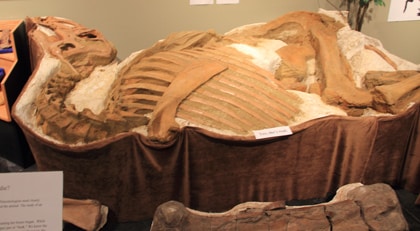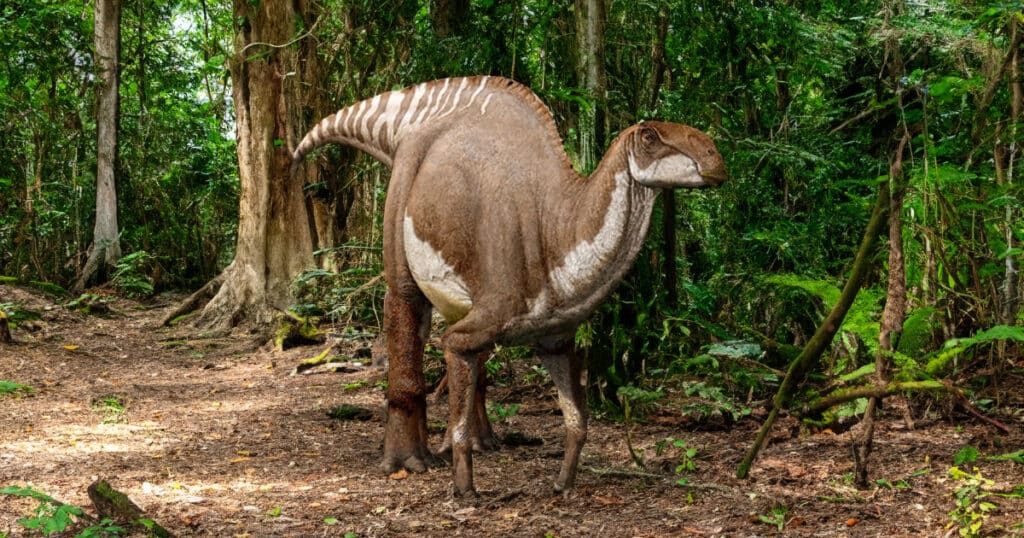Meet Leonardo, a 77-million-year-old sub-adult Brachylophosaurus canadensis. His fossilized skeleton is covered in soft tissue–skin, scales, muscle, foot pads–and even his last meal is in his stomach. The actual tissue has fossilized, but Leonardo presents the world with its first look at a dinosaur in the flesh.

“This unique discovery will completely change what we know about all dinosaurs and the world in which they lived,” says Nate Murphy, world-renowned dinosaur paleontologist and Leonardo principal investigator. “In short, Leonardo is as close to Jurassic Park as we’re ever going to get.”
Leonardo was discovered in Montana, USA, in 2000. His preservation is unprecedented, providing an unparalleled glimpse into dinosaur biology.
“We have to really invent new science just to study this specimen. You can’t just scrape the dirt off the bones because that dirt is the soft tissue. I can’t wait to see what we discover when we look at this with new technologies.” – Dr. James Kirkland
Description of Brachylophosaurus

Brachylophosaurus canadensis was a mid-sized herbivorous dinosaur known for its distinctive flat, paddle-like crest on its head. It lived during the Late Cretaceous period, around 77 million years ago. This dinosaur measured about 9 metres in length and had a robust body adapted for grazing on plants.
Its fossils have been found primarily in North America. From these discoveries, we’ve gained valuable insights into the ecosystem and biodiversity of the ancient floodplain environments it inhabited. For example, the well-preserved remains of Brachylophosaurus have revealed details about its diet, which included ferns, conifers, and other low-lying vegetation.
The structure of its teeth and jaws indicates it was well-adapted to processing tough plant material. Additionally, the discovery of skin impressions and potential soft tissue suggests that Brachylophosaurus had a scaly skin texture.

Significance of the Find
Leonardo is, quite simply, the “King Tut” of dinosaurs. This specimen possesses many features that will provide scientists with a clearer picture of what dinosaurs looked like. Some of these features include the following:
- Muscle mass
- Confirmed stomach contents
- Throat pouch, or “crop”
- Fleshy frill along its back
- Possible presence of a tongue
- Unquestionable articulation of all limbs
- Apparent confirmation of muscle attachment and limb movement
- Potential presence of internal organs
Scientific Contributions
Studies of Leonardo have already provided insights into dinosaur skin texture and muscle structure. Ongoing research uses advanced technologies like CT scans and chemical analysis to uncover more details about his biology.
Public Engagement
It isn’t often that an opportunity to influence millions of children in a healthy direction presents itself to the corporate community. Through Leonardo, and dinosaurs in general, we have such an opportunity to conceptually recreate an extinct species. Leonardo’s fossil has been exhibited in museums, engaging the public and promoting science education.
The mere mention of the word dinosaur inspires an unmatched sense of awe and wonder in both adults and kids alike. Simply put, the world is fascinated by these massive prehistoric beasts. We intend to use this fascination as a way to help stimulate interest in science education that will, in many children, grow into a burning desire to learn and explore.